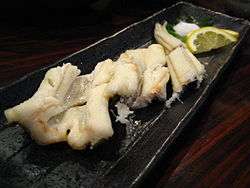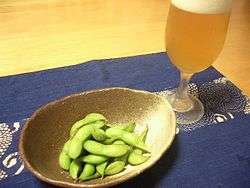Definify.com
Definition 2025
肴
肴
Translingual
Han character
肴 (radical 130 肉+4, 8 strokes, cangjie input 大大月 (KKB), four-corner 40227, composition ⿱㐅有)
References
- KangXi: page 976, character 18
- Dai Kanwa Jiten: character 29322
- Dae Jaweon: page 1427, character 31
- Hanyu Da Zidian: volume 3, page 2049, character 17
- Unihan data for U+80B4
Chinese
Glyph origin
| Characters in the same phonetic series (爻) (Zhengzhang, 2003) | |
|---|---|
| Old Chinese | |
| 崤 | *ɢaːw, *ɢraːw |
| 郩 | *qaːwʔ |
| 敎 | *kraːw, *kraːws |
| 較 | *kreːwɢs, *kreːwɢ |
| 肴 | *ɢraːw |
| 淆 | *ɢraːw |
| 倄 | *ɢraːw, *ɢʷɯːʔ |
| 爻 | *ɢraːw |
| 餚 | *ɢraːw |
| 殽 | *ɢraːw |
| 笅 | *ɢraːw |
| 駁 | *praːwɢ |
Phono-semantic compound (形聲, OC *ɢraːw) : phonetic 爻 (OC *ɢraːw) + semantic ⺼ (“meat”) – meat dishes. The character 爻 also has meaning of “cut, divided, sliced”, so connotations of “sliced meat, prepared meat”.
Current form resembles 乂 + 有 – the lower 乂 of 爻 has moved to the side and down.
Etymology 1
|
simp. and trad. |
肴 | |
|---|---|---|
Pronunciation
- Mandarin
- (Standard Chinese, Beijing)+
- Pinyin:
- Zhuyin: ㄧㄠˊ
- Wade-Giles: yao2
- Gwoyeu Romatzyh: yau
- IPA (key): /i̯ɑʊ̯³⁵/
- (Standard Chinese, Beijing)+
- Cantonese
- (Standard Cantonese, Guangzhou)+
- Jyutping: ngaau4
- Yale: ngàauh
- Cantonese Pinyin: ngaau4
- IPA (key): /ŋɑːu̯²¹/
- (Standard Cantonese, Guangzhou)+
- Min Nan
- (Hokkien: Quanzhou, Xiamen, Zhangzhou)
- Pe̍h-ōe-jī: hâu
- Tâi-lô: hâu
- Phofsit Daibuun: haau
- IPA (Quanzhou): /haʊ²⁴/
- IPA (Xiamen): /haʊ²⁴/
- IPA (Zhangzhou): /haʊ¹³/
- (Hokkien: Quanzhou)
- Pe̍h-ōe-jī: gâu
- Tâi-lô: gâu
- Phofsit Daibuun: gaau
- IPA (Quanzhou): /gaʊ²⁴/
- (Hokkien: mainstream Taiwanese, Xiamen, Zhangzhou)
- Pe̍h-ōe-jī: ngâu
- Tâi-lô: ngâu
- Phofsit Daibuun: ngaau
- IPA (Taipei): /ŋaʊ²⁴/
- IPA (Kaohsiung): /ŋaʊ²³/
- IPA (Xiamen): /ŋaʊ²⁴/
- IPA (Zhangzhou): /ŋaʊ¹³/
- Note: hâu - literary; gâu/ngâu - vernacular (俗).
- (Hokkien: Quanzhou, Xiamen, Zhangzhou)
| Rime | |
|---|---|
| Character | 肴 |
| Reading # | 1/1 |
| Initial (聲) | 匣 (33) |
| Final (韻) | 肴 (90) |
| Tone (調) | Level (Ø) |
| Openness (開合) | Open |
| Division (等) | II |
| Fanqie | 胡茅切 |
| Reconstructions | |
| Zhengzhang Shangfang |
/ɦˠau/ |
| Pan Wuyun |
/ɦᵚau/ |
| Shao Rongfen |
/ɣau/ |
| Edwin Pulleyblank |
/ɦaɨw/ |
| Li Rong |
/ɣau/ |
| Wang Li |
/ɣau/ |
| Bernard Karlgren |
/ɣau/ |
| Expected Mandarin Reflex |
xiáo |
| Baxter-Sagart system 1.1 (2014) | |
|---|---|
| Character | 肴 |
| Reading # | 1/1 |
| Modern Beijing (Pinyin) |
yáo |
| Middle Chinese |
‹ hæw › |
| Old Chinese |
/*[ɡ]ˤraw/ |
| English | food |
Notes for Old Chinese notations in the Baxter-Sagart system: * Parentheses "()" indicate uncertain presence; | |
| Zhengzhang system (2003) | |
|---|---|
| Character | 肴 |
| Reading # | 1/1 |
| No. | 14645 |
| Phonetic component |
爻 |
| Rime group |
宵 |
| Rime subdivision |
1 |
| Corresponding MC rime |
肴 |
| Old Chinese |
/*ɢraːw/ |
Definitions
肴
- This term needs a translation to English. Please help out and add a translation, then remove the text
{{rfdef}}.
Compounds
Etymology 2
| For pronunciation and definitions of 肴 – see 餚. (This character, 肴, is the simplified form of 餚.) |
Notes:
|
Japanese
Kanji
(“Jinmeiyō” kanji used for names)
- This term needs a translation to English. Please help out and add a translation, then remove the text
{{rfdef}}.
Readings
Compounds
|
Etymology 1
| Kanji in this term |
|---|
| 肴 |
|
さかな Jinmeiyō |
| kun'yomi |
Compound of Old Japanese elements 酒 (saka, “sake, rice wine”, old combining form of modern sake reading) + 菜 (na, “side dish”).[1][2][3] Likely source of Okinawan さかな (sakana).
Pronunciation
Alternative forms
Noun
肴 (hiragana さかな, romaji sakana)
- fish
- a side dish served with alcoholic beverages: not necessarily fish, may be a vegetable or other meat
- entertainment at a drinking party
Usage notes
The fish sense is more commonly spelled 魚.
Idioms
|
Etymology 2

| Kanji in this term |
|---|
| 肴 |
|
な Jinmeiyō |
| kun'yomi |
From Old Japanese. Also spelled variously in kanji in modern Japanese as 肴 (for meat or fish), 菜 (for vegetables), 魚 (for fish).[1]
This reading appears to be obsolete in modern Japanese.
Pronunciation
Noun
Derived terms
References
- 1 2 1988, 国語大辞典(新装版) (Kokugo Dai Jiten, Revised Edition) (in Japanese), Tōkyō: Shogakukan
- 1 2 2006, 大辞林 (Daijirin), Third Edition (in Japanese), Tōkyō: Sanseidō, ISBN 4-385-13905-9
- ↑ 1995, 大辞泉 (Daijisen) (in Japanese), Tōkyō: Shogakukan, ISBN 4-09-501211-0
- ↑ 1998, NHK日本語発音アクセント辞典 (NHK Japanese Pronunciation Accent Dictionary) (in Japanese), Tōkyō: NHK, ISBN 978-4-14-011112-3
Korean
Hanja
肴 • (hyo) (hangeul 효, revised hyo, McCune-Reischauer hyo, Yale hyo)
- This term needs a translation to English. Please help out and add a translation, then remove the text
{{rfdef}}.
